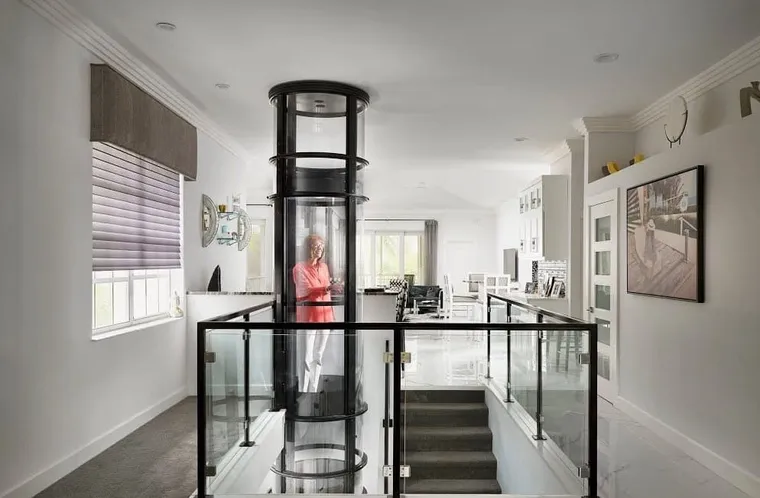These innovative solutions are changing the way people think about vertical mobility at home. Whether you’re planning for aging in place, enhancing property value, or simply looking to add a touch of futuristic convenience to your home, these residential elevators might surprise you.
1. Vacuum Tube Elevators – A Space-Age Solution
Vacuum tube elevators, also known as pneumatic elevators, are one of the most fascinating innovations in the home elevator market. They look like something straight out of a science fiction movie. These elevators use air pressure to lift and lower the cab, eliminating the need for traditional cables, pulleys, or hydraulic systems.
One of the biggest advantages? They require minimal space. Because they don’t need a machine room or a deep pit, they can be installed even in smaller homes where space is limited. The transparent, cylindrical design also adds a modern architectural flair, making them a conversation piece as much as a functional tool. Best of all, installation can often be completed within a few days.
2. Through-the-Floor Elevators – Disappear When Not in Use
If preserving floor space is your priority, through-the-floor elevators offer a clever solution. These compact lifts are designed to travel through a specially cut opening in the floor between levels. When not in use, the elevator retracts completely to one level, leaving no visible shaft or obstruction.
Through-the-floor elevators are perfect for homeowners who want discreet mobility solutions without compromising their home’s layout. They are particularly popular among older adults who want to future-proof their homes without undergoing major renovations. Despite their small footprint, they offer smooth, quiet operation and stylish finishes that blend seamlessly with modern interior design.
3. Outdoor Residential Elevators – Take It Outside
Most people don’t realize that residential elevators aren’t limited to the inside of the home. Outdoor elevators are becoming increasingly popular, especially for homes built on sloped lots or properties with elevated decks and patios.
Outdoor elevators are weather-resistant and constructed from durable materials like stainless steel and powder-coated aluminum. They can be a game-changer for waterfront homes, hillside properties, and homes with multiple exterior living spaces. Imagine effortlessly moving between your garden, pool deck, and upper-level balcony without stairs or heavy lifting.
4. Chair Lifts and Vertical Platform Lifts – Simple Yet Effective
While not technically elevators in the traditional sense, chair lifts and vertical platform lifts deserve a mention. Chair lifts are often installed along staircases, allowing users to glide smoothly up and down the stairs while seated.
Vertical platform lifts, on the other hand, function more like a mini-elevator, lifting a wheelchair or standing passenger vertically over short distances—perfect for porch entrances or small height differences inside the home. Both options are cost-effective and require minimal structural modifications, making them ideal for quick accessibility upgrades.
5. Compact Cable-Driven Elevators – Big Function, Small Space
For those who prefer the reliability of cable systems but don’t have the space for a traditional elevator shaft, compact cable-driven elevators offer the perfect compromise. These systems have been redesigned to fit smaller footprints without sacrificing safety or performance.
Modern models feature sleek glass panels, whisper-quiet motors, and advanced safety mechanisms. Some even come with smart home integration, allowing you to call the elevator from your phone or integrate it with home automation systems.
Why Consider a Home Elevator?
Beyond the wow factor, residential elevators are becoming practical necessities for many families. Aging homeowners are increasingly choosing to stay in their homes longer rather than moving to assisted living facilities. Adding an elevator makes this possible, providing safe and easy access to all floors without the strain of stairs.
Additionally, home elevators can significantly boost property value. In competitive real estate markets, having mobility-friendly features makes a home more attractive to a broader range of buyers, including families planning for multi-generational living.
How Much Do These Elevators Cost?
The cost of these modern elevators varies depending on the type, size, and customization options. Pneumatic elevators typically start around $35,000 to $50,000, while through-the-floor models can be slightly less, starting at around $25,000. Chair lifts and platform lifts are the most affordable, often starting under $10,000. While this may seem like a significant investment, many homeowners find it’s a worthwhile addition for convenience, safety, and long-term value.
Final Thoughts
Residential home elevators are no longer just luxury items for the wealthy. With advances in design, technology, and installation options, they’re becoming accessible, practical, and even essential for modern living. Whether you’re thinking ahead for aging in place or simply want to add a unique architectural element to your home, these innovative elevator solutions might just be what you didn’t know you needed. Take a look—you may be surprised at how easily vertical mobility can fit into your home and lifestyle.
